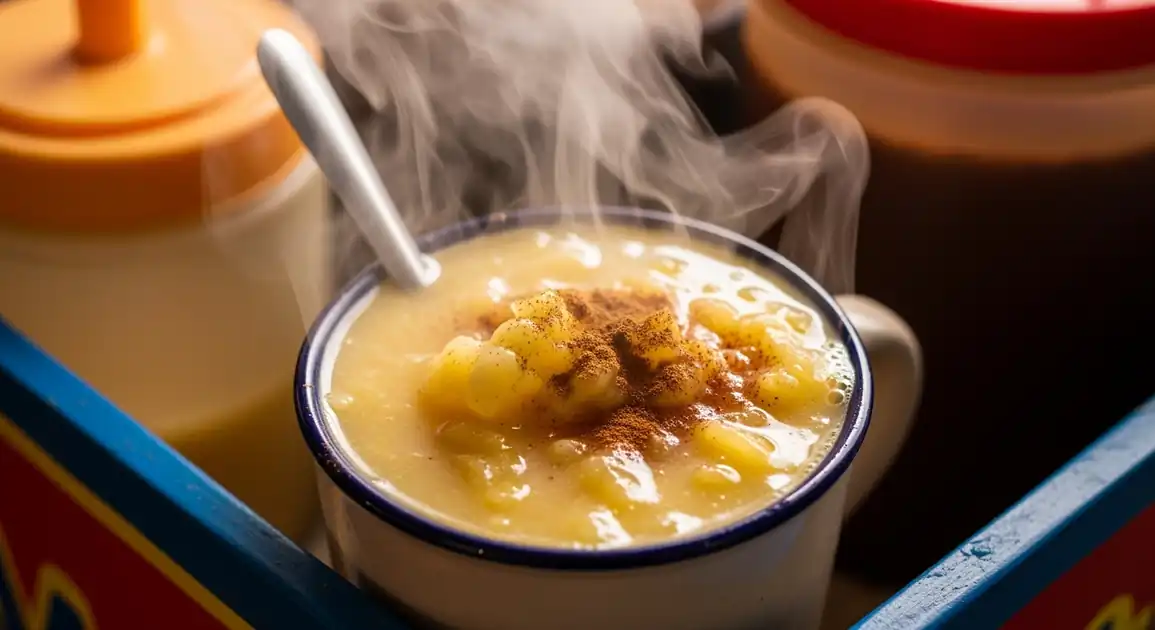Champús (Peruvian Fruity Corn Beverage)
Champús

Description
Lima is the heartland of Peruvian Champús. It's an integral part of the city's street food tapestry, especially beloved during the cool, damp winter months ('invierno limeño'). Vendors ('champuceros/as') appear in the afternoons and evenings across many districts, serving the steaming, fruity beverage from large pots on carts. Key areas include the historic center and around popular markets.
Dietary Information
Serving information
Serving style
Almost exclusively served hot in disposable cups, with a sprinkle of cinnamon on top and often a plastic spoon. Sold for immediate consumption.
Quick facts
Commonly found from 3 PM / 4 PM until 9 PM / 10 PM daily.
Safety Tips
What to Look For
-
Served piping hot with visible steam
Ensures the beverage is held at a temperature that inhibits bacterial growth and is authentic to how it's traditionally served.
-
Clean vendor station, pot, and utensils
General cleanliness indicates better hygiene practices, reducing contamination risk.
-
High customer turnover
A busy vendor usually means the Champús is fresh and hasn't been sitting for an excessively long time.
-
Fresh appearance and aroma
The Champús should smell fruity and spiced, not sour or fermented. Fruit pieces (like mote) should look fresh.
What to avoid
-
Lukewarm Champús
Temperatures below piping hot can allow bacteria to multiply. Insist on hot servings.
-
Dirty pots, ladles, or serving cups
Obvious sign of poor hygiene standards and potential for contamination.
-
Vendors using questionable water sources (if visible)
Although hard to assess, avoid vendors if their water handling seems unsanitary.
-
Champús that looks dull, separated, or smells sour/fermented
Indicates the product might be old or improperly prepared.
Price information
Price range
Budget tips
- Expect to pay around 3-5 PEN for a standard cup from a street vendor.
- Prices are very consistent across most street vendors.
- Slightly higher prices might be found inside formal market food courts or restaurants.
Value indicators
- Served steaming hot.
- Noticeable aroma of fruit and spices.
- Vendor has a steady stream of customers.
- Clean ladle and serving area.
Where to Find This Dish
Centro Histórico (Downtown Lima)
High concentration of street vendors, especially along Jirón de la Unión and near Plaza San Martín in the late afternoon/evening.
Jirón de la Unión, Plaza San Martín, Plaza Mayor
Afternoon, Evening
Around Mercado Surquillo
The streets surrounding this popular market often host various food vendors, including Champús carts.
Mercado Surquillo No. 1, Near intersection Av. Angamos / Paseo de la República
Afternoon, Evening
Lince District
Known for its commercial activity and street food scene, especially around the Risso commercial center.
Centro Comercial Risso, Mercado de Lince
Afternoon, Evening
Residential Neighborhoods
Local vendors often have established spots within residential areas, particularly near parks or main avenues.
Varies by neighborhood
Afternoon, Evening
Vendor Tips
- Look for vendors with large, insulated pots to maintain heat effectively.
- Don't be afraid to ask for 'bien caliente' (very hot) if you are concerned about temperature.
- Some vendors might offer a taste if you are hesitant, but don't necessarily expect it.
How to Order
Regional Variations
-
'Champús Carretillero' Style
(Champús de Carretilla)
Refers to the classic street vendor style, often emphasizing traditional recipes and preparation methods passed down through families.
-
Guanábana-Forward Champús
(Champús con harta Guanábana)
Some vendors might be known for using a particularly generous amount or high quality of guanábana, making its flavor dominant.
Cultural context
History
The origins of Champús are debated, with some tracing it back to pre-Columbian times, utilizing native corn and fruits. The name might have African roots, possibly adapted over colonial times. It became deeply embedded in Lima's street food culture ('comida de carretilla'), particularly associated with Afro-Peruvian traditions and neighborhood vendors ('champuceras') who prepared and sold it, offering warmth during the city's damp 'garúa' season.
Local significance
Champús is deeply ingrained in Lima's identity, representing affordable, comforting street food. It evokes nostalgia and is a symbol of resilience against the city's gray winters.
Eating customs
- Holding the warm cup to warm hands on chilly evenings.
- Stirring to ensure the mote doesn't settle at the bottom.
- Finishing the cup while it's still pleasantly warm.